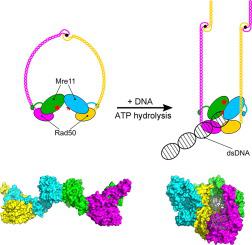Computational and Structural Biotechnology Journal ( IF 6 ) Pub Date : 2020-05-16 , DOI: 10.1016/j.csbj.2020.05.013 Renata Tisi 1 , Jacopo Vertemara 1 , Giuseppe Zampella 1 , Maria Pia Longhese 1

|
Chromosomal DNA double-strand breaks (DSBs) are potentially lethal DNA lesions that pose a significant threat to genome stability and therefore need to be repaired to preserve genome integrity. Eukaryotic cells possess two main mechanisms for repairing DSBs: non-homologous end-joining (NHEJ) and homologous recombination (HR). HR requires that the 5′ terminated strands at both DNA ends are nucleolytically degraded by a concerted action of nucleases in a process termed DNA-end resection. This degradation leads to the formation of 3′-ended single-stranded DNA (ssDNA) ends that are essential to use homologous DNA sequences for repair. The evolutionarily conserved Mre11-Rad50-Xrs2/NBS1 complex (MRX/MRN) has enzymatic and structural activities to initiate DSB resection and to maintain the DSB ends tethered to each other for their repair. Furthermore, it is required to recruit and activate the protein kinase Tel1/ATM, which plays a key role in DSB signaling. All these functions depend on ATP-regulated DNA binding and nucleolytic activities of the complex. Several structures have been obtained in recent years for Mre11 and Rad50 subunits from archaea, and a few from the bacterial and eukaryotic orthologs. Nevertheless, the mechanism of activation of this protein complex is yet to be fully elucidated. In this review, we focused on recent biophysical and structural insights on the MRX complex and their interplay.
中文翻译:

对MRX / MRN复合体的功能和结构方面的见解,这是识别和修复DNA双链断裂的关键因素。
染色体DNA双链断裂(DSB)是潜在的致命DNA损伤,对基因组稳定性构成重大威胁,因此需要修复以保持基因组完整性。真核细胞具有修复DSB的两种主要机制:非同源末端连接(NHEJ)和同源重组(HR)。HR要求在称为DNA末端切除的过程中,通过核酸酶的协同作用将两个DNA末端的5'终止链进行核酸水解降解。这种降解导致形成3'端单链DNA(ssDNA)末端,这对于使用同源DNA序列进行修复至关重要。进化上保守的Mre11-Rad50-Xrs2 / NBS1复合体(MRX / MRN)具有酶和结构活性,可以启动DSB切除并维持DSB末端彼此束缚进行修复。此外,需要募集并激活蛋白激酶Tel1 / ATM,后者在DSB信号传导中起关键作用。所有这些功能都取决于ATP调节的DNA结合和复合物的溶核活性。近年来,已从古细菌中获得了Mre11和Rad50亚基的几种结构,并从细菌和真核直向同源物中获得了一些结构。然而,该蛋白复合物的激活机制尚未完全阐明。在这篇综述中,我们重点研究了MRX复合物及其相互作用的最新生物物理和结构见解。近年来,已从古细菌中获得了Mre11和Rad50亚基的几种结构,并从细菌和真核直向同源物中获得了一些结构。然而,该蛋白复合物的激活机制尚未完全阐明。在这篇综述中,我们重点关注了MRX复合物及其相互作用的最新生物物理和结构见解。近年来,已从古细菌中获得了Mre11和Rad50亚基的几种结构,并从细菌和真核直向同源物中获得了一些结构。然而,该蛋白复合物的激活机制尚未完全阐明。在这篇综述中,我们重点研究了MRX复合物及其相互作用的最新生物物理和结构见解。


























 京公网安备 11010802027423号
京公网安备 11010802027423号